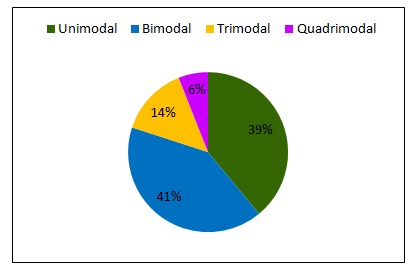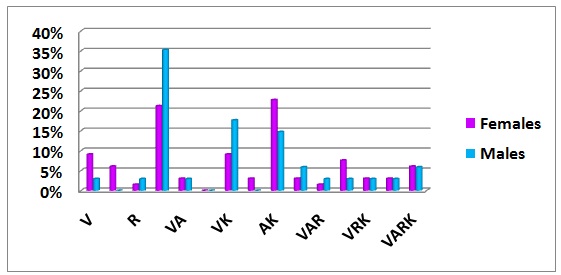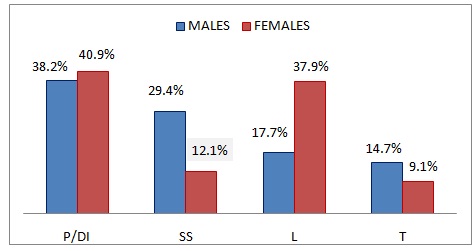Recent years have seen a change in the trends of medical education from pedagogy to andragogy i.e. from a teacher-centred learning to a student-centred learning. Therefore, it is not only desirable but also essential for educators to recognize that adults have different learning styles and that they should tailor instructions to the characteristic ways in which the adults prefer to learn [1,2]. The term, ‘learning style’ describes an individual’s preferred method of gathering, processing, interpreting, organizing and analyzing information. The VARK model which was developed by Fleming and Mills [3] provides the learners with a profile of their learning styles, based on the sensory modalities which are involved in taking in information. VARK is an acronym for the Visual (V), Auditory (A), Read/Write (R) and the Kinaesthetic (K) sensory modalities. The visual learners process the information best if they can see it. The auditory learners like to hear information. The read-write learners prefer to see the written words. The kinaesthetic learners like to acquire information through experience and practice.
Various instructional methods which are used for teaching the first year medical students include lectures, dissections, practicals, tutorials, etc. The students’ preference for different teaching-learning methods had been attributed in the past to a number of reasons such as familiarity with the method, a positive outcome, etc. A less explored but perhaps a more significant factor could be the students’ learning styles. Having knowledge on the learners’ learning styles is a vastly underutilized approach towards an improvement in the classroom instructions. The learning style information can also benefit the students as it would help them in formulating the appropriate learning strategies for enhancing their learning. Most of the previous studies which have been done in the medical arena on the learning styles have been conducted in other countries and the results have shown variations, may be due to the use of different teaching methodologies at the premedical level [4].To the best of our knowledge, none of the studies have correlated the preferences of the instructional methods with the learning styles of the medical students. The aim of the present study was therefore, to gain an understanding of the learning style preferences of first semester medical students, to find out the most preferred instructional methods and to correlate these methods with the learning preferences of the students, which could be helpful in formulating teaching —learning strategies for improving the learning experience.
MATERIAL AND METHODS
This study was conducted on the first year medical students who were enrolled at the School of Medical Sciences and Research, Sharda University, Greater Noida, Uttar Pradesh, India. A total of 100 students voluntarily participated in the study (66 females and 34 males). Two separate questionnaires were used to determine the students’ most preferred teaching-learning methods and their learning style preferences. The first questionnaire was used to obtain the general demographic information i.e. names, ages and genders of the students, as well as to assess their preferences of the teaching-learning methodologies (Lectures, Practicals/Dissections, Tutorials, Self study) in the descending order of the preference. The second questionnaire, the latest version (7.1) of the VARK questionnaire, which was developed by Fleming [5], was used to determine the learning style preferences of the students. It consisted of 13 questions with four options each and the respondents could choose more than one option if they found them suitable. The VARK model was used in the present study because it a. addressed a part of the learning styles that was open to self-modification, b. it was accompanied by study strategies for each style, c. it could help in formulating teaching strategies and d. it was the most popular model due to its simplicity and reliability.
The purpose of the study was explained to the students and the hard copies of the questionnaires were distributed to the students who volunteered to take the analysis. The completed questionnaires were collected after 15-20 minutes and they were evaluated by using previously validated scoring instructions which were available on the VARK website.
Descriptive statistics was used to analyze the students’ preferences of the various VARK components, as well as their preferences for the various teaching-learning methods. The Students’ t-test was utilized to compare the VARK scores for the male and female students and Pearson’s Correlation Co-efficient was employed to analyze the correlation between the learning styles and the most preferred teaching- learning methods.
RESULTS
According to the VARK model, the students’ learning styles are dependent on how they prefer to perceive/receive information. They may prefer a single mode (unimodal), two modes (bimodal), three modes (trimodal) or all four modes (quadrimodal) of the information presentation. In the present study, it was found that 61% students had multimodal learning style preferences and that only 39% students had unimodal preferences. Amongst the multimodal learning styles, the most preferred mode was bimodal, followed by trimodal and quadrimodal respectively [Table/Fig-1].
Percentages of students with unimodal, bimodal, trimodal & quadrimodal preferences

Of the 39% students who had unimodal learning styles, 26% preferred the kinaesthetic mode, 7% preferred the visual mode, 4% preferred the auditory mode and only 2% preferred the read-write mode. Therefore, the kinaesthetic mode was the most preferred mode and the read—write the least preferred mode of the information presentation.
The learning style preferences of the female students were more varied, which included all the bimodal (VA, VK, VR, AK AR, KR) and the trimodal (VAK, VAR, AKR and VRK) learning styles, whereas in the male student population, the VR and AR bimodal combinations were not represented [Table/Fig-2].
Distribution of various combinations of learning styles in male & female students. V- visual, A- auditory, R- read-write, K- kinaesthetic

[Table/Fig-3] shows the comparison of the preferences for the four VARK modalties of the female and male students. It was observed that a significantly higher number of female students preferred the auditory mode of the learning style as compared to the males; whereas a significantly higher number of male students preferred the kinaesthetic mode (p value <0.05).
Comparison of VARK Scores of Male & Female Students
| VARK Mode | Male/Female Students | Mean ± SD | p value |
|---|
| Visual | Female | 5.83±2.33 | 0.03* |
| Male | 4.83±2.29 |
| Auditory | Female | 5.23±1.61 | 0.13 |
| Male | 4.76±1.81 |
| Read-Write | Female | 3.79±1.90 | 0.39 |
| Male | 3.66±2.31 |
| Kinaesthetic | Female | 5.98±2.14 | 0.002* |
| Male | 7.45±2.01 |
(* p value<0.05, student’s “t” test)
Various teaching-learning methods such as a. direct instruction methods (lectures and demonstrations), b. interactive instruction methods (tutorials), c. experimental learning methods (practicals and dissections) and d. independent study methods ( self study) are used to impart and acquire knowledge of the basic sciences during first year of the medical curriculum. The most preferred teaching-learning method among all the students was practicals/dissections (39%), followed by lectures (32%), self study (18%) and tutorials (11%). Among the female students, the second most preferred teaching—learning methodology was lectures, whereas the male students preferred self study following practicals/dissections [Table/Fig-4].
Comparison of preference of teaching-learning methods among male and female students.P/DI- Practical/Dissection, SS-Self study, L-Lecture, T-Tutorial

The correlation between the students’ learning styles and their preferences of the teaching-learning methods is shown in [Table/Fig-5]. The most preferred VARK mode was the kinaesthetic and the most preferred teaching—learning method was practical/dissection. A positive correlation (Pearson’s ccorrelation coefficient, r = 0.752) was observed between the preferences of the VARK modes and the teaching learning methods.
Correlation between students’ preference for VARK modes and teaching-learning methods
| Preferred mode of teaching -learning method | Practical/Dissection | Lecture | Tutorial | Self Study |
|---|
| %age of students | 39 | 32 | 11 | 18 |
| VARK Mode | K | V | A | R |
| Mean score | 13.43 | 10.66 | 9.99 | 7.45 |
DISCUSSION
The educational world is acknowledging the importance of understanding the students’ different learning style preferences and their role in attaining academic success [6,7]. In the present study, therefore, we administered the VARK questionnaire to the first year medical students to determine their learning style preferences. A majority of the students (61%) exhibited multimodal learning style preferences, which indicated that they preferred multiple modes of information presentation. The results of previous studies which were conducted on first year medical students from various other countries also reported similar results; however, the percentage of students with multimodal learning style preferences in these studies varied from 59-85% [4,8–10].This implies that most of the students learn effectively as long as the teaching methods include a blend of activities that stimulate the visual, aural, read-write and the kinaesthetic sensory modalities. The increasing use of multimedia in teaching can provide opportunities for presenting multiple representations of the content (text, video, audio, images and interactive elements) to cater more effectively to the diverse learning styles of the students. Neuroscience research has also revealed that significant increases in learning can be accomplished when the learning environments cater to their predominant learning styles [11]. This is known as the “meshing hypothesis” [12].
In the unimodal learning style category, we found that the most preferred mode was the kinaesthetic one, followed by the visual, auditory and the read-write ones. Therefore, the active learning strategies such as role playing, simulations, use of models, debates, etc which are preferred by the kinaesthetic learners would be more beneficial to the students than the traditional lecture formats. Active learning strategies not only encourage the critical thinking (evaluation, analysis, and interpretation of the information) but they also improve the problem solving and the decision making skills. A passive learning strategy format such as lectures mainly caters to the auditory learners. In the present study, the percentage of the auditory learners was much less as compared to those of the kinaesthetic and the visual learners. Our findings were comparable to the results of the study which was conducted by Baykan and Nacar [13] on first year medical students from Turkey. According to Lujan and DiCarlo [14], the most preferred learning style of the first year medical students was read/write among the students from Indiana, USA. However, Nuzhat et al., [4] reported that the auditory mode was the most preferred learning style among the medical students from Saudi Arabia. The variations in the learning preferences of the medical students from different countries could be explained on the basis of the differences in the teaching methodologies which are being used at the premedical level and the exposure to the hands on clinical experiences in the first year of the medical curriculum.
There is no single best teaching-learning strategy that can work for every student, no matter how good that approach is. Some previous studies have reported that certain teaching-learning methods, such as problem based learning, are favoured over the traditional methods i.e. lectures [15,16]. However, only little is known on whether the learning style of a student affects his/her preference for a specific teaching strategy/instructional method. The data from this study revealed that practicals/dissections were the most favoured teaching methodology of both male and female students. This fact can be associated with the finding that the most preferred learning style of the student population of the present study was the kinaesthetic one. The kinaesthetic learners prefer the hands on approach to learning and therefore, the students with this learning style prefer to perceive information best through practical sessions. Further, it was observed that the second most favoured teaching methodology of the female students was lectures, which could be explained by the fact that higher numbers of female students had a preference for auditory and visual modalities. This indicated that the choice of the teaching methodologies was affected to a certain extent by the learning styles of the students.
Unmatched learning styles and teaching— learning methodologies may adversely affect the learning on the part of the students [17,18] and therefore, tailoring instruction methods to the students’ learning style preferences is advocated [18].
Providing training and opportunities to the medical educators to develop an understanding of the students’ learning style preferences can result in a greater comprehension and consideration of the unique learning needs of each student who is under their tutelage. Correlating the students’ learning style preferences and instructional needs can assist the teachers in using appropriate teaching-learning instructional practices and it can also provide personalized interventions for enhancing the learning.
One of the limitations of the study was its relatively small sample size. For this reason, these findings cannot be generalized to all the medical students. Secondly, like any other learning style inventory, VARK analyzes only one aspect of the learning style.
In future, further studies need to be conducted to a. study the correlation between the performances and the learning styles of students, b. find out whether the learning styles of the students change as they progress from the pre-clinical phase to the clinical phase of the curriculum.
CONCLUSIONS
The knowledge on the learning styles has implications for both the medical teachers and the students. The students identify their learning preferences, which can help them in using the appropriate learning strategies and as a result, they are more likely to become lifelong self directed learners and to maximize their true potential. The teachers become aware of the students’ learning styles and they can therefore incorporate teaching-learning strategies which are tailored to meet the students’ learning preferences. This would not only create an efficient learning environment, but it would also motivate the students to achieve academic success.
(* p value<0.05, student’s “t” test)